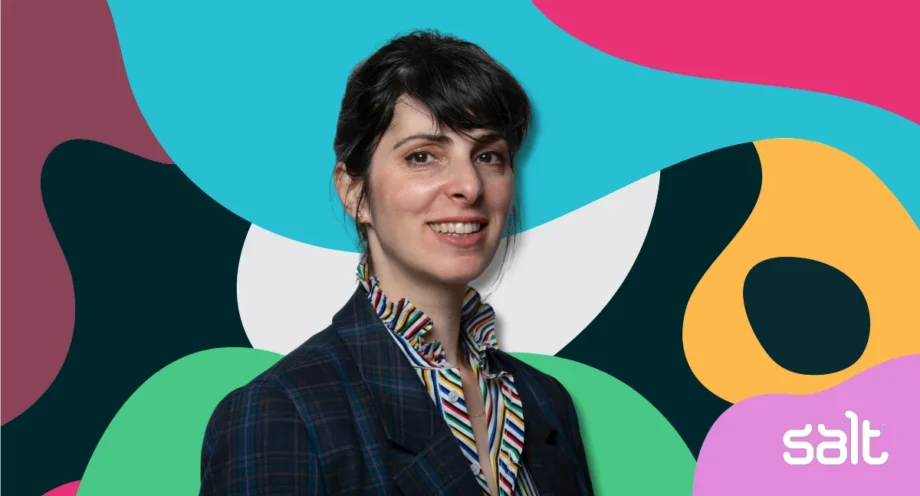Shifts and trends in the UX Market with Elite Avner Torbit
Hiring permanent staff over freelancers is a growing trend in the UX industry - hear an insider's perspective from Elite Avner Torbit

Hiring permanent staff over freelancers has been a growing trend in the UX market over 2023. In this interview, Elite Avner Torbit, CX/UX Manager at Wolters Kluwer UK, shares her take on why the market has shifted, and what UX leaders need to know to foster collaboration and success.
In this interview series Associate Director Consultant for Creative, Holley Potts, gives you a snapshot into Product, UX and Creative career journeys.
Hiring in UX Design? Salt can help.
Looking for your next UX role? We have some amazing opportunities for you!
A word from Holley Potts
The UX market shifted in 2023. Aside from 2020, the conditions are unlike anything we’ve seen in the last 20 years, with fewer roles and more uncertainty. There has been a marked shift in candidates and hiring managers seeking permanent roles, and senior, experienced talent going for mid-weight or reduced-rate positions.
I’m so excited to share insights and practical advice from Elite Avner Torbit. She leads on setting up UX operations, building teams and driving business to integrate UX into the core of its strategy and operations. We discuss the latest trends, technologies and strategies.
Want to work with Holley? Get in touch on LinkedIn
What trends have you seen in the UX job market in 2023?
I have seen a lot of very experienced people applying for jobs which was a little bit surprising.
When we recruit for senior positions, there is a natural hierarchy already in place. We are looking for people with around 4 to 7 years of experience and yet we have people applying with 15 or 20 years of experience.
In comparison to previous years, there is more brilliant talent looking for permanent jobs. Previously it has been difficult to source permanent staff. We used to only be able to get people that were looking for freelance roles, because of the work-life balance it offers them. I think things have changed to the point where that balance is now the expectation for permanent roles too, as flexible working is a more common benefit for full-time workers.
I think it has been more competitive on the research side than the design side of the UX job market this year. There are some very good UX researchers out there, but it’s been difficult to recruit senior researchers.
These are the trends we are seeing here at Wolters Kluwer, whether that reflects the general market or not I don’t know. However, in my own experience, I have found it slightly easier to find good people.
How has the UX design team at Wolters Kluwer grown?
Both businesses’ focus on UX and their maturity in terms of UX seem to be growing globally.
When I started in this 5 years ago, I was the first designer hired. As a company, we now have 9 designers in my team. From a global perspective, they are also scaling up Product Heads.
Wolters Kluwer specifically is a company that has performed well in the last few years. For example, the division that deals with taxes and accounting is pretty solid, and that is an industry that tends to survive all sorts of economic downturns. So far, so good!
We have also now got an Operations Manager in place, who I hired last year. As a company, we are constantly educating functions not used to working with designers about how to collaborate effectively to achieve amazing results.
How does being a freelancer compare to being a permanent member of staff?
Before I joined Wolters Kluwer, I was freelancing for quite a few years. In this more consultative role, I enjoyed going from place to place, and I remember thinking it’s quite nice not to have to get involved in internal politics.
What I didn’t get when I freelanced that I enjoy so much now is the ability to make something and see it come to life and be able to improve it. The longevity of the projects that you work on is what makes them so very satisfying. And in a permanent role, you feel part of the team! As an integrated part of the company and the product, you get quite attached and that’s something really special.
There’s a sense of belonging you won’t necessarily get when you work for an agency.
Everybody cares about the customers and about creating the best products we can. This creates some tension sometimes, especially because we are a young UX function.
Bringing in design thinking methodologies is a challenge because not everyone buys into it. This is again so different from the experience you have when you’re a consultant or freelancer, when the business pays for you to come in and just do your thing. When you’re internal and permanent, you get asked more questions, and you need to get people to buy into your methodology.
Weighing up the decision to go freelance? Here are the pros and cons to help you choose.
How do you get stakeholders to buy into your UX design methodology?
What we do is very collaborative. We enhance collaboration by building cross-functional teams. We have people representing different functions in the business at every step of the design process.
Being able to educate people is key — so we can show the importance of researching and validating any assumptions. This kind of change takes time.
Those less exposed to UX language and processes take some time to understand the approach and way of thinking. They might say things like: “I think we should do this. This is the solution. It’s going to work.”
To change that mindset, we do usability research or validation exercises. We get feedback from the customers themselves. We also work closely with our Product Managers. Product Managers are our best friends!
It is all about collaboration and making sure that we don’t work in a silo.
In our business, we don’t have Project Managers who come with a design team because we’ve got a huge development function.
Our Design Operations Manager is there to help us with collaboration. They create and build relationships with other departments, so they have the opportunity to ask others how they would like to collaborate with a design team. Gathering and understanding these perspectives allows us to fine-tune our processes.
Successful collaboration means making sure that we invite and encourage non-designers in the team (so the Product Owners, Managers, and Developers) to come along to testing, and see our analysis in progress for themselves.
Looking for your next UX role? We have some amazing opportunities for you!
How are emerging technologies and design trends shaping the UX landscape and influencing user behaviour?
Our customers are our accounting practices. For them, changing systems is key because we are their B2B software.
Changing systems is a tough, long-winded, and expensive procedure. There is a marked change in the end clients’ expectations in terms of the tools that the accountant delivers.
We work with a wide range of end clients, including those from the older generation and young creatives to technology startups. Their needs and expectations differ.
We know that as a UX function, it’s really important for us to get out of the house. To make sure that we reach those people who aren’t even our direct customers. A wide reach helps ensure our customers evolve what they can offer with our support.

